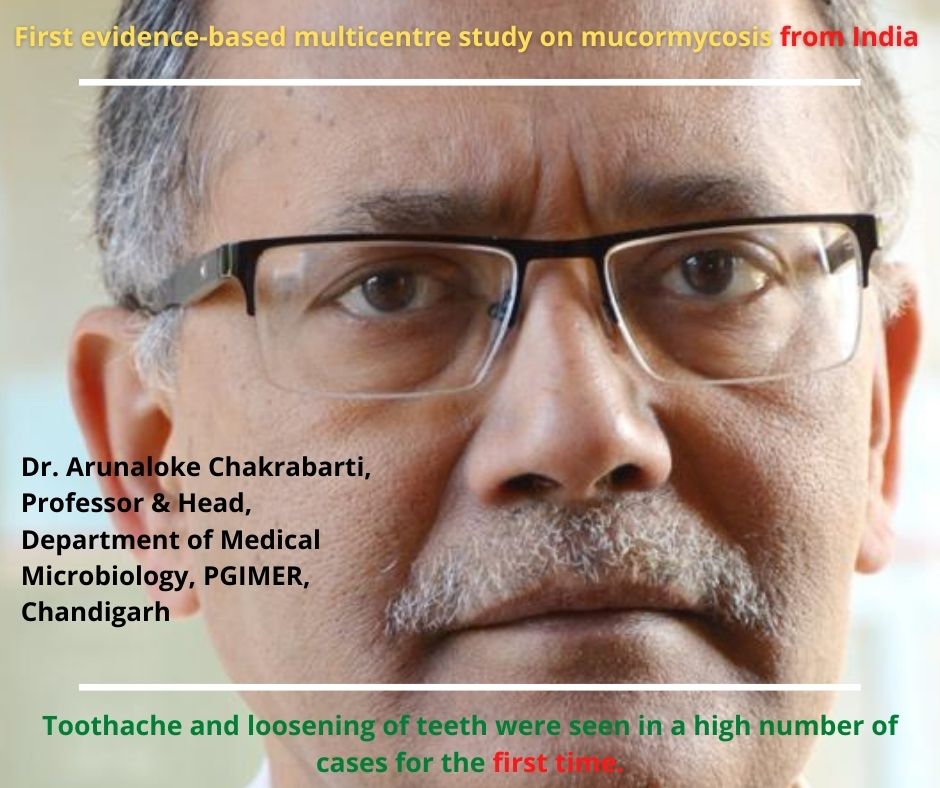Doctors at PGIMER, Chandigarh conducted a study with the name of MucoCovi (Muco from mucormycosis, Covi from COVID119) at 16 centres across the country and found that the most common sites of infection were found to be nose with eye involvement (in 58% cases) followed by nose with eye and brain involvement (27% cases) and then lung infection (9% cases). It shows a considerable number of patients reported late to the hospital after the disease progression to the brain. Besides facial pain, nasal blockage and discharge; toothache and loosening of teeth were seen in a high number of cases for the first time.
The study results were published yesterday in the reputed Emerging Infectious Disease Journal (Journal of CDC, Atlanta, USA) as ‘Multicenter Epidemiologic Study of Coronavirus Disease-associated Mucormycosis, India’.
Dr. Arunaloke Chakrabarti, Professor & Head, Department of Medical Microbiology, PGIMER detailed the Study as he said, ” In the MucoCovi Network study, 16 healthcare centers across India participated to provide detailed information about proven mucormycosis cases with and without COVID-19 infection reported during September 1–December 31, 2020. The prevalence of Covid Associated Mucormycosis (CAM) was 0.27% in patients managed in hospital wards and 1.6% in patients managed in ICUs. There was a 2.1-fold rise in mucormycosis cases during 2020 in India compared to the year 2019 and the research suggests that this increase is attributable to the COVID-19 pandemic.”
It was seen that on an average CAM diagnosis was made 18 days after COVID-19 infection. The most common sites of infection were found to be nose with eye involvement (in 58% cases) followed by nose with eye and brain involvement (27% cases) and then lung infection (9% cases). It shows a considerable number of patients reported late to the hospital after the disease progression to the brain. Besides facial pain, nasal blockage and discharge; toothache and loosening of teeth were seen in a high number of cases for the first time.
On comparing the cases of CAM with mucormycosis without COVID-19 (i.e. Non-CAM) it was seen that uncontrolled diabetes mellitus was the most common underlying disease in both groups. In patients with CAM, newly detected diabetes mellitus was more frequent compared to Non-CAM cases (20.9% versus 10%). This suggests the direct role of COVID-19 in causing or worsening diabetes, which may predispose these patients to mucormycosis.
In fact, patients with diabetic ketoacidosis developed CAM early i.e. in less than 8 days of COVID-19. On the other hand, those patients who developed CAM later had mostly received steroid treatment. It was seen that inappropriate use of steroids (63.3%) i.e. either in very high doses or use in patients who did not need it was associated with development of late CAM, i.e. more than 8 day after COVID-19 diagnosis.
The overall death rate due to mucormycosis (both CAM and Non-CAM) was 38.3% at 6 weeks and 45.7% after 12 weeks of illness. It was seen that patients >54 years of age, those with brain or lung involvement and those who had to undergo ICU admission had a higher risk for death. The authors conclude that the COVID-19 pandemic has resulted in a rise in cases of mucormycosis from India. Mucormycosis is a critical problem complicating the later part of the clinical course of COVID-19 in India, due to improper glucocorticoid usage.
The rise in number of cases coincides with the country’s COVID-19 epidemic. Clinicians should be vigilant for mucormycosis in the patients recovering from COVID-19 illness, especially among patients with new or previously diagnosed diabetes mellitus and clinical manifestations of facial or orbital pain or black or blood-stained nasal discharge or loosening of teeth. In addition, improper glucocorticoid use for the COVID-19 treatment is an additional risk factor in CAM. Therefore, treating physicians should ensure they use appropriate drugs and doses in COVID-19 patient treatments.
This study is the first evidence-based multicentre study on mucormycosis from India. The study could remove many myths surrounding the emergence of mucormycosis. Uncontrolled diabetes and improper steroid use are major important factors for the emergence, though the study could not look into the role of COVID19 virus in causing immunity disturbance leading to mucormycosis. Considering those gaps in the study, the doctors of PGI have planned another large-scale multicentre study at 30 centres of the country. They are hopeful to bring out the study results within the next three months.
